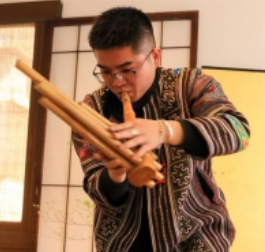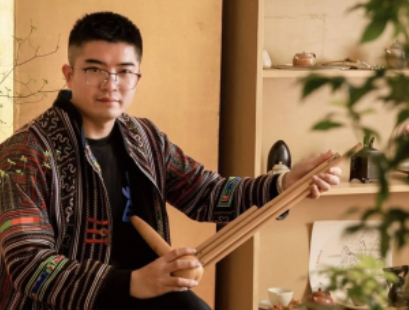Xu Weisheng: Inheritor of the intangible cultural heritage "Yao Nationality Lusheng Making Skills"
Selecting the right bamboo, installing the reeds of the reed, calibrating the scale of the reed... After dozens of processes, the ordinary bamboo slowly transformed into a reed with a round sound and exquisite workmanship in Xu Weisheng's hands. As a representative inheritor of the intangible cultural heritage "Yao nationality reed production skills", although Xu Weisheng is only a young man born in 1995, he has already become a well-known "old master" in the circle in improving and innovating Yao nationality reed production skills. He made the ancient national musical instruments more suitable for the audio-visual needs of modern people, and played a more beautiful melody.
"Rescue" skills take the initiative to drop out of school
Reeds are very popular in ethnic minority areas such as Miao, Yao and Dong. Xu Weisheng, who was born in Laowuli Village, Gepo Town, Fuchuan Yao Autonomous County, has listened to old people blowing reeds and telling stories related to reeds since he was a child. Xu Weisheng also fell in love with Lusheng, and studied with teachers everywhere. He found that with the passage of time, fewer and fewer old people in the village mastered the craftsmanship of reeds, and he couldn't help but feel anxious.

Between 2015 and 2016, two folk masters who taught Xu Weisheng to make reeds passed away one after another, which caused a shock to him, who was preparing for his junior year. "I have to race against time to rescue those national cultures that are about to disappear." That year, Xu Weisheng made a decision that was opposed by everyone around him: drop out of school and go home and devote himself to the inheritance of Lusheng culture.
Improved reeds are widely recognized
In order to strengthen his belief and remind himself of his mission, Xu Weisheng also changed his name. He changed the last word in the name to "sheng" of Lusheng.
Back at his hometown, Xu Weisheng opened a workshop upstairs and began to concentrate on the production of reeds. He told reporters that the reeds of the Yao nationality are slightly different from those of other ethnic minorities, and most of the production techniques have been lost. He visited many Yao villages to search for and record the production techniques and performance methods of the Yao nationality reeds. The wooden bucket reed he restored has been recognized by domestic reed research experts.

"When I first started learning to make reeds, I found that the reeds made according to the ancient method had a narrow range of sound, the sound quality was not strong enough, and the tunes that could be played were relatively simple." Xu Weisheng realized that in order to pass on the Yao nationality reeds, innovations must be made. He began to explore, from the traditional wooden bucket six-pipe six-tone reed, to the wooden bucket fifteen-pipe fifteen-tone reed, eight-pipe sixteen-tone gourd... The improved reed has different timbres and shapes, and is more suitable for First of all, the needs of contemporary music performance.
In 2017, Xu Weisheng participated in the appraisal of the "Bagui Tiangong Award" of Guangxi arts and crafts with the improved Yao nationality reeds, and won the bronze medal at the autonomous region level. In 2020, he was nominated for the "Top Ten Reformers of Chinese National Musical Instruments" for his improved Yao nationality reeds.
Carry old books with you
Working with ancient national musical instruments all day, and living a life of picking bamboos in the mountains, and going down the mountains with tools such as saws, planes, hammers, files, etc., Xu Weisheng remains optimistic and sunny. Dressed up with a national flavor, he can play on the spot as long as he picks up the reed, and he can dance while playing, which can instantly bring the happy atmosphere to life.
When Xu Weisheng went out, he also carried a lot of ancient books with him. When he took out a thick stack of documents from his bag and showed them to reporters, he was a little surprised. He said with a smile, this is to read it immediately when he is inspired, or use them as corroborating materials when discussing the reed culture with people.
As more and more people are familiar with Yao culture, Xu Weisheng has more confidence in inheriting Lusheng. In 2016, he began to receive apprentices in the local area to pass on art, and led the villagers to set up the "Yao Ancient Culture and Art Troupe" to perform in various places. "I want to cultivate more Yao culture lovers and inheritors, let more people know about our Yao culture, and let more and more people like reeds and our handicrafts." Xu Weisheng is full of confidence in the future.
 渝公网安备 50010702504639号
渝公网安备 50010702504639号